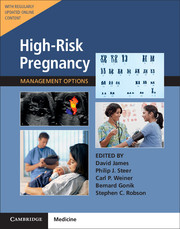Book contents
- Frontmatter
- Contents
- List of Contributors
- Preface
- Section 1 Prepregnancy Problems
- Section 2 Early Prenatal Problems
- Section 3 Late Prenatal – Fetal Problems
- Section 4 Problems Associated with Infection
- Section 5 Late Pregnancy – Maternal Problems
- Section 6 Late Prenatal – Obstetric Problems
- 52 Abdominal Pain in Pregnancy
- 53 Nonmalignant Gynecology in Pregnancy
- 54 Bleeding in Late Pregnancy
- 55 Multiple Pregnancy
- 56 Threatened and Actual Preterm Labor
- 57 Prelabor Rupture of the Membranes
- 58 Breech Presentation, Unstable Lie, Malpresentation, and Malpositions
- 59 Prolonged Pregnancy
- 60 Induction of Labor and Termination of the Previable Pregnancy
- 61 Dysfunctional Labor
- 62 Shoulder Dystocia
- 63 Fetal Compromise in Labor
- 64 Neuraxial Analgesia and Anesthesia in Obstetrics
- 65 Perineal Repair and Pelvic Floor Injury
- 66 Assisted Vaginal Delivery
- 67 Delivery After Previous Cesarean Section
- 68 Cesarean Section
- Section 7 Postnatal Problems
- Section 8 Normal Values
- Index
59 - Prolonged Pregnancy
from Section 6 - Late Prenatal – Obstetric Problems
- Frontmatter
- Contents
- List of Contributors
- Preface
- Section 1 Prepregnancy Problems
- Section 2 Early Prenatal Problems
- Section 3 Late Prenatal – Fetal Problems
- Section 4 Problems Associated with Infection
- Section 5 Late Pregnancy – Maternal Problems
- Section 6 Late Prenatal – Obstetric Problems
- 52 Abdominal Pain in Pregnancy
- 53 Nonmalignant Gynecology in Pregnancy
- 54 Bleeding in Late Pregnancy
- 55 Multiple Pregnancy
- 56 Threatened and Actual Preterm Labor
- 57 Prelabor Rupture of the Membranes
- 58 Breech Presentation, Unstable Lie, Malpresentation, and Malpositions
- 59 Prolonged Pregnancy
- 60 Induction of Labor and Termination of the Previable Pregnancy
- 61 Dysfunctional Labor
- 62 Shoulder Dystocia
- 63 Fetal Compromise in Labor
- 64 Neuraxial Analgesia and Anesthesia in Obstetrics
- 65 Perineal Repair and Pelvic Floor Injury
- 66 Assisted Vaginal Delivery
- 67 Delivery After Previous Cesarean Section
- 68 Cesarean Section
- Section 7 Postnatal Problems
- Section 8 Normal Values
- Index
Summary
Introduction
Prolonged or post-term pregnancies are associated with an increased risk of perinatal mortality and morbidity when compared with pregnancies ending at term. This adverse outcome is mainly associated with placental insufficiency, meconium aspiration syndrome, macrosomia, and birth injury. Consequently, induction of labor in order to prevent the complications of prolonged pregnancy is one of the commonest interventions in pregnancy, with up to 29% of pregnant women undergoing this procedure.
It is, therefore, important to clarify the upper limit of a normal human gestation, in order to determine when an intervention is justified. We immediately encounter the problem of defining what exactly is “normal.” For example, a pregnancy may be considered statistically prolonged if the gestation falls in the top 5% of the distribution of gestational lengths for a given population. Conversely, a pregnancy may be considered prolonged from a clinical management point of view when the risk to the fetus of continuing the pregnancy is higher than its risk after birth. On a population basis, we therefore need to discover when in the statistical distribution of gestational age the increasing risks of postmaturity justify induction, which is not in itself risk-free. Moreover, because fetuses mature at different rates, we need to look for factors in each individual pregnancy that can be used to modulate the average risk. One hypothesis for the increased risk of perinatal mortality in a clinically prolonged pregnancy is “placental insufficiency,” in which the aging placenta is no longer able to keep pace with the demands of the growing fetus, resulting in either fetal malnutrition or asphyxia, or both. Assessment of fetal growth and wellbeing may, therefore, be used to modify in each individual pregnancy the precise gestation at which postmaturity is judged to be a risk justifying induction.
Definition
The current World Health Organization (WHO) definitions for preterm, term, and post-term took effect in 1977, sanctioned by the International Federation of Gynecology and Obstetrics (FIGO). A baby is born at “term” if the delivery occurs at or between 37 completed weeks and 41+6 weeks from the first day of the last menstrual period (LMP).
- Type
- Chapter
- Information
- High-Risk Pregnancy: Management OptionsFive-Year Institutional Subscription with Online Updates, pp. 1697 - 1708Publisher: Cambridge University PressFirst published in: 2017
- 1
- Cited by

